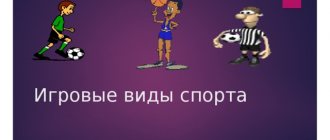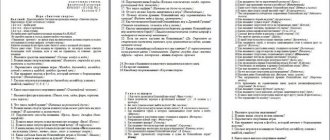Athletics “appears” in a child’s life even before he begins to practice it in a sports club. From an early age, he passes through obstacles, climbs stairs (if you have one in your house/apartment), and climbs onto various chairs and beds.
At school and in the yard, children are constantly active. They play catch and standard children's games: for example, hopscotch. Also, they run “races”. For this reason, athletics are popular among children. It combines almost all the exercises that kids did in childhood.
Athletics is easy to learn and useful from the point of view of physical development. And every child needs to play sports to be healthy and strong.
At what age can you start?
Experts in the field of this sport do not recommend that children of preschool age practice it. They understand that athletics is simple from a “technical” point of view. But they believe that children will not be able to master it at such an early age.
Doctors advise sending a child to this sport when he can consciously do everything he is told. He must be disciplined, restrained, and able to focus his attention on training. If there are problems with the latter, the trainer will not be able to teach the child how to perform the exercises correctly. The toddler will be constantly distracted, and the coach will not want to make comments to him all the time. It is better to send your toddler to sports at an older age.
Example
. It’s difficult for kids at four years old to even master running. They can't learn to start. Children literally do not see the line - they constantly step over it, or start running before the whistle sounds. The coach has to pay a huge amount of attention to the child to teach him the basics. Accordingly, this takes a lot of time.
Older children will not have this problem. In first grade, a child will be able to master the above in a couple of lessons.
You can take your child to this sport at any age. Even from the age of three. But you are unlikely to achieve the effect.
You need to engage in this sport from at least seven to eight years old. At this age, children are already developed enough to master the basics of this sport in a minimum amount of time.
Which children are suitable for athletics?
To understand whether athletics is suitable for your child, you can take a special test, or you can simply watch your child. If he is active, enjoys playing with the ball, playing catch and blind man's buff, and constantly encourages you to go for walks outside, any athletics sport will be a joy for him and will benefit him.
The exception is hyperactive children. Such kids are not able to listen to the coach and maintain discipline, so athletics is not suitable for them. It is better to send hyperactive children to martial arts, where children learn to control their emotions and concentrate energy.
If you don't know how to identify a child's sport, use our test here.
Medical contraindications
Athletics has contraindications. They need to be taken into account so that problems do not arise during training in the future.
You cannot engage in this sport if your child has:
Heart problems- The respiratory
system is unstable.
Kidney problems- Increased
blood sugar. - Problems
with muscles or joints. Keep in mind that during exercise the body muscles are very tense. If there are problems with the muscles and joints, the child’s health will be at risk.
Doctors also do not recommend this sport for children who are hyperactive. If a child cannot sit still and is constantly moving, then nothing can make him disciplined. And, especially, athletics.
In hyperactive toddlers, the nervous system is almost always “excited”. During competitions, they will feel excitement and show strong emotions. What can stop them from winning as they start making mistakes.
Composure is required in competitions. Otherwise, nothing will work.
The positive aspects of this sport
This sport has a positive effect on children's health.
- If
your baby works hard in training, he will be able to strengthen his bones and develop muscles. He will become stronger, more agile and faster. The little one will be able to endure physical activity more easily, and his immunity will be strengthened. - The child’s psychological health will be strengthened.
He will be able to set a professional goal for himself and try to achieve it. And if it doesn’t work out, then he can learn not to “give up” and will continue to work on himself. This is a positive skill. In the future, your child will also be able to set goals for himself at work and achieve them. He will become a successful businessman, or simply build a career in a large company. - Any child can participate in athletics.
You can train either in any sports section or on the street. To practice athletics, you don't need a lot of special equipment. It’s enough just to go out to the schoolyard and practice on the sports ground. - The child can decide for himself which “specialization” to choose
. There are many types of competitions in athletics. The baby can independently choose what to do: run, jump, throw various objects, do all-around events or race walking. - The kid learns to work in a team
. This sport teaches you not to be selfish, and to think, among other things, about the people who are on your team. Most competitions feature relay races. There, each team member must act harmoniously to win. If he doesn't do this, the whole team will lose. And it will not be possible to achieve the desired result.
Final test of knowledge in physical education in grades 10-11, section “Athletics”
#10th grade #11th grade #Physical education #Republic of Crimea #Federal State Educational Standards #Methodological developments #Subject teacher #School education #Fragment of lesson #UMK ed. V. I. Lyakha
Final test for testing knowledge in physical education in grades 10-11, section “Athletics” Test author: Valentina Nikolaevna Sikorskaya: physical education teacher, State Budgetary Educational Institution Secondary School No. 25
Instructions for the test (25 questions in total) The test includes the following tasks: Select 1 correct answer out of 4; Choose 2 correct answers out of 5; Select 1 incorrect option; Matching Question (Definition Meaning) Sequencing Questions; Define the concept. Creative task (10 minutes) Time to answer the test 10 seconds, click to show the correct answer
Question No. 1 The distance in a sprint is: 100 m From 60 m to 400 m to 800 m to 100 m (Choose one answer) Correct answer: 2
Question 2 In sprint running, the most common is... High start Low start Running All (Choose one answer) Correct answer: 2
Question No. 3 Starting acceleration is... ... the distance from the start to the middle of the distance. ... part of the take-off distance. ... part of the distance in which it is necessary to increase the frequency and length of the step. ... the first 60 m of the distance. Select one answer Correct answer: 3
Question No. 4 Which discipline is not part of athletics? Race walking Throwing All-around Acrobatics Correct answer: 4
Question No. 5 Mittelsträcker running is Long-distance running Short-distance running Middle-distance running Jogging Select one answer Correct answer: 3
Question No. 6 Methods of long jumping “Fosbury flop” “triple” with a pole “cross over” “bent over” Name 2 correct options Correct answer: 2 and 5
Question No. 7 Methods of high jumping “Fosbury flop” “triple” with a pole “changeover” “bending over” Name 2 correct options Correct answer: 1 and 4
Question No. 8 Sequence of movements in a jump Run-up - flight - push-off - landing Run-up - push-off - flight - landing Take-off - run-up - flight - landing Take-off - flight - run-up - landing Select one correct option Correct answer: 2
Question No. 9 Types of athletics jumps Long, wide, deep, high, Into water Name 2 correct options Correct answer: 1, 4
Question No. 10 Running types of athletics Sprint Long distance Relay running Obstacle running Shuttle running Running in pairs Name one incorrect option Correct answer: 6
Question No. 11 Name non-Olympic projectiles for throwing Javelin Hammer Cannonball Disc Grenade Correct answer: 5
Question No. 12 Types of competitions in Athletics 1. Competitions are held for the purpose of selecting athletes for the national team or to monitor their level of preparedness; 2. Competitions in athletics, where places are distributed; 3. Competitions in athletics are held for the purpose of selection for the main competitions; 4. Competitions are held for everyone, only permission from a doctor is required; Main Qualification Open Qualifying (control)
Question No. 13 At what distances is running carried out on a straight treadmill? Up to 200 m Up to 110 m Up to 60 m All Name one correct option Correct answer 2
Question No. 14 Name a typical mistake in race walking technique From the moment you place your foot on the track until the moment it lifts off the ground, the leg should be straightened at the knee joint; Presence of flight phase; There must always be contact with the support; Lack of flight phase. Correct answer 2
Question No. 15 The baton must be passed (handover zone). In a 20-meter corridor In a 100-meter corridor From hand to hand In any meter of distance Name one correct answer Correct answer 1
Question No. 16 Name the sequence in decreasing order of competition participants in round-robin judging: a) semi-finals;; b) finals; c) heats d) quarter-finals; The correct answer is c, d, a, b.
Question No. 17 Name the components of a jump in the correct sequence: Repulsion Braking Running Flight Landing Correct answer: 3, 1, 4, 5.
Question No. 18 A long jumper must pay special attention to the development of... Strength Jumping Flexibility Speed Name one correct option Correct answer 1
Question No. 20 Give the concept of defining the physical quality of a person. A person’s ability to perform actions with certain muscle tensions. Correct answer: Strength
Question No. 21 Give the concept of defining the physical quality of a person. A person’s ability to perform work for a significant period of time without reducing the load’s intensity or the body’s ability to resist fatigue. Correct answer: Endurance
Question No. 22 Give the concept of defining the physical quality of a person. A person’s ability to perform motor actions in a minimum period of time for given conditions. Correct answer: Speed
Question No. 23 Give the concept of defining the physical quality of a person. The ability to master complex motor movements and quickly and rationally rearrange one’s actions in accordance with changing situations. Correct answer: Dexterity
Question No. 24 Give the concept of defining the physical quality of a person. Physical ability associated with the ability to control movements in space and time Correct answer: Coordination
Question No. 25 Give the concept of defining the physical quality of a person. The physical ability of a person to perform motor actions with the required range of motion. Correct answer: Flexibility
Creative task Create an all-around athletics program for competitions at the Girls' Health Day for boys in the gym. Boys for girls at the stadium. Control time 10 minutes
Negative sides
Athletics is a really interesting sport. But at the same time, he is also dangerous.
Most athletes who have been involved in this sport for a long time have joint diseases. Their vertebrae are displaced. During training, they often get various dislocations and sprains. Sometimes they even break limbs. And you need to be prepared for this.
Always make your child stretch before training. Otherwise, the above cannot be avoided.
What is the cost of classes?
Athletics is the cheapest sport of all.
Moreover, as we said earlier, you can train for free. To do this, you can go outside and practice on some sports ground. And it will be even better than in the gym. Because fresh air strengthens the body.
If you decide to send your child to professional sports, we recommend choosing a section that operates at the school. Classes there can be either free (if the group is funded by the state) or very cheap - the price will be much lower than in private clubs.
You will also need to purchase special equipment. But don't worry, its price is not high. You only need to buy a special suit and sneakers that your child will wear. Nothing else will be needed.
Typically, such a kit can be purchased for a couple of thousand rubles. Of course, each region of Russia has its own prices for certain items of clothing, but it is quite possible to keep within 2,000.
Be sure to ask your trainer what additional equipment he or she will need. If they tell you to buy something extra, then do it. These things will be useful to your child during further training.







